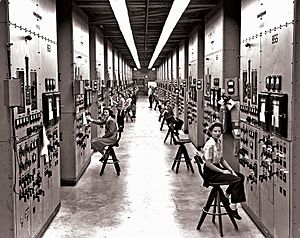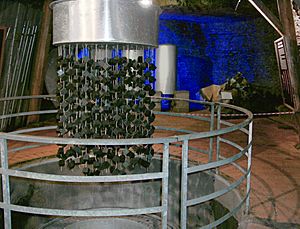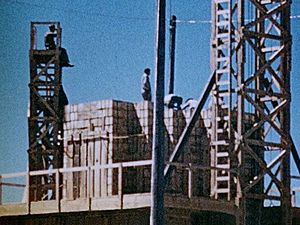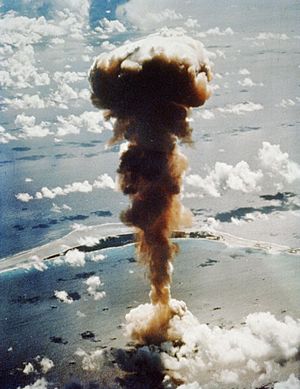Timeline of the Manhattan Project facts for kids
The Manhattan Project was a top-secret research and development project during World War II. Its main goal was to create the very first atomic bombs. The United States led this huge effort, with help from the United Kingdom and Canada.
From 1942 to 1946, Major General Leslie Groves from the US Army Corps of Engineers was in charge. The Army's part of the project was called the Manhattan District. Soon, "Manhattan" became the secret name for the whole project. It even included an earlier British project called Tube Alloys.
The Manhattan Project started small in 1939. But it quickly grew to employ over 130,000 people! It cost almost $2 billion, which was a huge amount of money back then. Most of this money (over 90%) was spent building factories and making the special materials needed for the bombs. Less than 10% went into actually designing and building the weapons.
Scientists developed two main types of atomic bombs during the war. One was a simpler "gun-type" bomb, which used a rare material called uranium-235. This material is hard to get because it's mixed with a more common type of uranium, uranium-238. To separate them, scientists used three different methods: electromagnetic, gaseous, and thermal. Much of this work happened in Oak Ridge, Tennessee.
At the same time, another team worked on making plutonium. They built special reactors in Oak Ridge and Hanford, Washington. In these reactors, uranium was changed into plutonium. Then, the plutonium was separated using chemicals. The "gun-type" design didn't work well with plutonium. So, a more complex "implosion-type" bomb was designed. This difficult work took place at the main research lab in Los Alamos, New Mexico.
This timeline shows important events of the Manhattan Project. It includes events before the project officially started and after the atomic bombings of Hiroshima and Nagasaki. The project officially ended in 1947 when it was replaced by the Atomic Energy Commission.
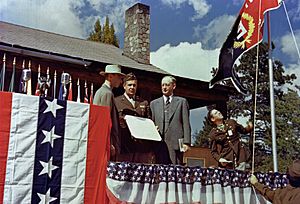
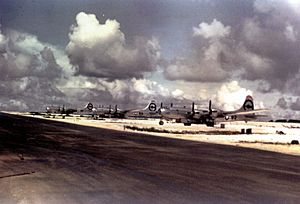
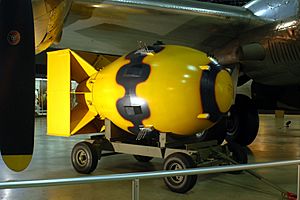
Contents
Key Moments in the Project
1939: The Beginning
- August 2: Famous scientist Albert Einstein signs a letter. It was written by physicist Leó Szilárd. The letter was sent to President Franklin D. Roosevelt. It warned him to fund research into using nuclear fission as a weapon. This was because Nazi Germany might be doing the same.
- September 3: Great Britain and France declare war on Nazi Germany. This was after Germany invaded Poland, starting World War II.
- October 11: Economist Alexander Sachs meets with President Roosevelt. He gives him the Einstein–Szilárd letter. Roosevelt then creates the Advisory Committee on Uranium.
- October 21: The first meeting of the Advisory Committee on Uranium takes place. It was led by Lyman James Briggs from the National Bureau of Standards. They set aside $6,000 for experiments with neutrons.
1940: Early Discoveries
- March 2: A team at Columbia University led by John R. Dunning confirms Niels Bohr's idea. They show that uranium 235 is responsible for fission when hit by slow neutrons.
- March: Scientists Otto Frisch and Rudolf Peierls in England write the Frisch–Peierls memorandum. They figure out that an atomic bomb might need only about 1 pound of enriched uranium to work.
- April 10: The MAUD Committee is set up in Britain. Its job is to see if an atomic bomb is possible.
- June 12: President Roosevelt creates the National Defense Research Committee (NDRC). Vannevar Bush leads it. This committee takes over the Uranium Committee.
1941: Growing Urgency
- February 25: Scientists Glenn Seaborg and Arthur Wahl at the University of California, Berkeley clearly discover plutonium.
- May 17: A report by Arthur Compton and the National Academy of Sciences says that developing nuclear power for military use looks promising.
- June 28: Roosevelt creates the Office of Scientific Research and Development (OSRD) under Vannevar Bush. This new office takes over the NDRC and the Uranium Committee.
- July 15: The MAUD Committee in Britain releases its final report. It details the design and costs to build a bomb.
- August: Mark Oliphant travels to the USA. He urges American scientists to focus on building a bomb, not just nuclear power.
- August 30: Winston Churchill becomes the first national leader to approve a nuclear weapons program. It was named Tube Alloys.
- October 9: Bush shows the MAUD Report to Roosevelt. Roosevelt approves a project to check the report's findings.
- December 6: Bush holds a meeting to speed up the research project. Harold Urey is assigned to study gaseous diffusion for uranium enrichment. Ernest O. Lawrence looks into electromagnetic separation, which led to the invention of the Calutron.
- December 7: Japan attacks Pearl Harbor. The United States and Great Britain declare war on Japan the next day.
- December 11: The United States declares war on Germany and Italy.
1942: The Project Takes Shape
- January 19: Roosevelt officially approves the atomic bomb project.
- January 24: Compton decides to bring all plutonium work to the University of Chicago.
- July–September: Physicist Robert Oppenheimer leads a conference at the University of California, Berkeley. They discuss how to design a fission bomb. Edward Teller brings up the idea of a hydrogen bomb.
- August 13: The Manhattan Engineering District is officially created. James C. Marshall is the first District Engineer.
- September 17: Colonel Leslie Groves is ordered to take over the project.
- September 23: Groves is promoted to brigadier general and becomes the project director.
- September 26: The Manhattan Project gets the highest wartime priority rating from the War Production Board.
- September 29: The Corps of Engineers is allowed to buy 56,000 acres in Tennessee. This will become Oak Ridge, Tennessee, a huge laboratory and production site.
- October 19: Groves chooses Oppenheimer to lead the scientific research at the Site Y laboratory.
- November 16: Groves and Oppenheimer visit Los Alamos, New Mexico. They choose it as the location for Site Y.
- December 2: Chicago Pile-1, the world's first nuclear reactor, starts working at the University of Chicago. It was built and led by Enrico Fermi. It achieved a self-sustaining reaction very quickly.
1943: Building the Facilities
- January 16: Groves approves building the Hanford Site.
- February 9: Another 400,000 acres are approved for Hanford.
- February 18: Construction begins for Y-12 at Oak Ridge. This is a massive plant for enriching uranium using electromagnetic separation.
- April 1: The Los Alamos laboratory is officially established.
- April 5–14: Robert Serber gives important introductory lectures at Los Alamos. These lectures were later put into a book called The Los Alamos Primer.
- June 2: Construction begins for K-25, the gaseous diffusion plant.
- July: Los Alamos, Clinton Engineer Works (Oak Ridge), and Hanford Engineer Works are declared military districts.
- August 13: The first test of a gun-type fission weapon is done at Dahlgren Proving Ground.
- August 13: Kenneth Nichols replaces Marshall as the head of the Manhattan Engineer District. He moves the headquarters to Oak Ridge.
- August 19: Roosevelt and Churchill sign the Quebec Agreement. The British Tube Alloys project officially joins the Manhattan Project.
- September 8: The first meeting of the Combined Policy Committee takes place. This committee was set up by the Quebec Agreement to coordinate efforts between the United States, United Kingdom, and Canada.
- October 10: Construction begins for the first reactor at the Hanford Site.
- November 4: The X-10 Graphite Reactor starts working at Oak Ridge.
- December 3: A group of 15 British scientists, including Rudolf Peierls and Klaus Fuchs, arrives in the USA.
1944: Challenges and Progress
- April 5: At Los Alamos, Emilio Segrè receives the first sample of plutonium made in a reactor. Within ten days, he finds that this plutonium fissions too easily on its own. This means it can't be used in the simpler "gun-type" bomb.
- May 9: The world's third reactor, LOPO, starts working at Los Alamos. It's the first to use enriched uranium.
- July 4: Oppenheimer tells the Los Alamos staff about Segrè's findings. This means the gun-type plutonium weapon design is in trouble.
- July 17: The "Thin Man" (the gun-type plutonium bomb) is abandoned. Designing a working implosion bomb (Fat Man) becomes the top priority. The design for the uranium gun-type bomb (Little Boy) continues.
- September 26: The largest nuclear reactor, the B reactor, starts working at the Hanford Site.
- Late November: Samuel Goudsmit of the Alsos Mission finds papers in France. He concludes that the Germans did not make much progress on an atomic bomb or reactor. Their programs were not a high priority.
- December 17: The 509th Composite Group is formed. Colonel Paul Tibbets leads this group. Their mission is to deliver the atomic bomb.
1945: The Atomic Bombs and End of War
- February 2: The first plutonium from Hanford arrives at Los Alamos.
- April 22: The Alsos Mission captures the German experimental nuclear reactor at Haigerloch.
- May 7: Nazi Germany officially surrenders to the Allied powers, ending World War II in Europe. A 100-ton test explosion happens at Alamogordo, New Mexico. This was a practice for the real atomic bomb test.
- May 28: The Target Committee meets for the third time. They finalize a list of cities where atomic bombs might be dropped: Kokura, Hiroshima, Niigata, and Kyoto.
- May 30: Henry Stimson, the Secretary of War, removes Kyoto from the target list. Nagasaki replaces it.
- June 11: Scientists from the Metallurgical Laboratory write the Franck Report. They argue that the bomb should be demonstrated first before being used on cities.
- July 16: The first nuclear explosion happens! This was the Trinity nuclear test of an implosion-style plutonium bomb, known as the gadget. It took place at Alamogordo. On the same day, the USS Indianapolis sails for Tinian with parts for the Little Boy bomb.
- July 24: President Harry S. Truman tells Soviet leader Joseph Stalin that the United States has atomic weapons. Stalin already knew this through spies.
- July 25: General Carl Spaatz is ordered to bomb one of the targets (Hiroshima, Kokura, Niigata, or Nagasaki) as soon as the weather allows, after August 3.
- July 26: The Potsdam Declaration is issued. It warns Japan of "prompt and utter destruction."
- August 6: The B-29 bomber Enola Gay drops Little Boy, a gun-type uranium-235 weapon, on Hiroshima, the primary target.
- August 9: The B-29 bomber Bockscar drops a Fat Man implosion-type plutonium weapon on Nagasaki, the secondary target. The primary target, Kokura, was covered by clouds.
- August 14: Japan surrenders to the Allied powers, ending World War II.
- August 21: Harry Daghlian, a physicist, is fatally exposed to radiation in a lab accident. He dies on September 15.
- October 16: Oppenheimer steps down as director of Los Alamos. Norris Bradbury takes over the next day.
1946: Post-War Tests and Control
- February: News of a Russian spy ring in Canada becomes public. This causes fear about "atomic spies" and makes American discussions about atomic control more strict.
- May 21: Physicist Louis Slotin is fatally exposed to radiation in another lab accident.
- July 1: The Able test happens at Bikini Atoll as part of Operation Crossroads. This was a nuclear weapon test.
- July 25: The underwater Baker test happens at Bikini.
- August 1: Truman signs the Atomic Energy Act of 1946 into law. This law ends uncertainty about who controls atomic research in the United States after the war.
1947: A New Era
- January 1: The Atomic Energy Act of 1946 (also known as the McMahon Act) takes effect. The Manhattan Project is officially handed over to the United States Atomic Energy Commission.
- August 15: The Manhattan District is officially ended.
|
See also
 In Spanish: Cronología del Proyecto Manhattan para niños
In Spanish: Cronología del Proyecto Manhattan para niños


